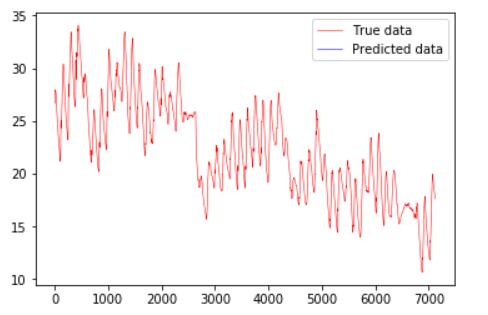Hi everyone,
I assigned different weight_decay for the parameters, and the training loss and testing loss were all nan.
I printed the prediction_train,loss_train,running_loss_train,prediction_test,loss_test,and running_loss_test ,they were all nan.
And I have checked the data with numpy.any(numpy.isnan(dataset)), it returned False.
If I use optimizer = torch.optim.Adam(wnn.parameters()) rather than assigning different weight_decay for the parameters, there would be no problem.
Could you please tell me how to fix it? Here are the codes, I defined the activation function by myself. Thank you:)
import numpy as np
import pandas as pd
import matplotlib.pyplot as plt
import torch
import torch.nn as nn
import torch.nn.functional as F
from torch.utils.data import Dataset, DataLoader
from torch.utils.data import TensorDataset
%matplotlib inline
data_temp=pd.read_csv('D:/Desktop/SEU/graduation/project/data/2017/processed4code/03.csv')
dataset=np.array(data_temp)
#np.any(np.isnan(dataset))
dataset_norm = (dataset - dataset.min()) / (dataset.max() - dataset.min())
data_df=pd.DataFrame(data=dataset_norm)
train_size=int(len(data_df)*0.75)
test_size=len(data_df)-train_size
train_set=pd.DataFrame(data=data_df.iloc[:train_size,:])
test_set=pd.DataFrame(data=data_df.iloc[train_size:,:])
train_set_x=pd.DataFrame(data=train_set.iloc[:,0:30])
train_set_y=pd.DataFrame(data=train_set.iloc[:,30])
test_set_x=pd.DataFrame(data=test_set.iloc[:,0:30])
test_set_y=pd.DataFrame(data=test_set.iloc[:,30])
train_set_x_array = np.array(train_set_x)
train_set_y_array=np.array(train_set_y)
test_set_x_array=np.array(test_set_x)
test_set_y_array=np.array(test_set_y)
train_set_x_tensor = torch.from_numpy(train_set_x_array).float()
train_set_y_tensor=torch.from_numpy(train_set_y_array).float()
test_set_x_tensor=torch.from_numpy(test_set_x_array).float()
test_set_y_tensor=torch.from_numpy(test_set_y_array).float()
train=TensorDataset(train_set_x_tensor,train_set_y_tensor)
test=TensorDataset(test_set_x_tensor,test_set_y_tensor)
trainloader = DataLoader(train, batch_size=10, shuffle=True)
testloader=DataLoader(test,batch_size=10,shuffle=False)
#My own activation function
class Morlet(nn.Module):
def __init__(self):
super(Morlet,self).__init__()
def forward(self,x):
x=(torch.cos(1.75*x))*(torch.exp(-0.5*x*x))
return x
morlet=Morlet()
class WNN(nn.Module):
def __init__(self):
super(WNN,self).__init__()
self.a1=torch.nn.Parameter(torch.randn(64,requires_grad=True))
self.b1=torch.nn.Parameter(torch.randn(64,requires_grad=True))
self.layer1=nn.Linear(30,64,bias=False)
self.out=nn.Linear(64,1)
def forward(self,x):
x=self.layer1(x)
x=(x-self.b1)/self.a1
x=morlet(x)
out=self.out(x)
return out
wnn=WNN()
optimizer = torch.optim.Adam([{'params': wnn.layer1.weight, 'weight_decay':0.01},
{'params': wnn.out.weight, 'weight_decay':0.01},
{'params': wnn.out.bias, 'weight_decay':0},
{'params': wnn.a1, 'weight_decay':0.01},
{'params': wnn.b1, 'weight_decay':0.01}])
criterion = nn.MSELoss()
for epoch in range(10):
prediction_test_list=[]
running_loss_train=0
running_loss_test=0
for i,(x1,y1) in enumerate(trainloader):
prediction_train=wnn(x1)
#print(prediction_train)
loss_train=criterion(prediction_train,y1)
#print(loss_train)
optimizer.zero_grad()
loss_train.backward()
optimizer.step()
running_loss_train+=loss_train.item()
#print(running_loss_train)
tr_loss=running_loss_train/train_set_y_array.shape[0]
for i,(x2,y2) in enumerate(testloader):
prediction_test=wnn(x2)
#print(prediction_test)
loss_test=criterion(prediction_test,y2)
#print(loss_test)
running_loss_test+=loss_test.item()
print(running_loss_test)
prediction_test_list.append(prediction_test.detach().cpu())
ts_loss=running_loss_test/test_set_y_array.shape[0]
print('Epoch {} Train Loss:{}, Test Loss:{}'.format(epoch+1,tr_loss,ts_loss))
test_set_y_array_plot=test_set_y_array*(dataset.max()-dataset.min())+dataset.min()
prediction_test_np=torch.cat(prediction_test_list).numpy()
prediction_test_plot=prediction_test_np*(dataset.max()-dataset.min())+dataset.min()
plt.plot(test_set_y_array_plot.flatten(),'r-',linewidth=0.5,label='True data')
plt.plot(prediction_test_plot,'b-',linewidth=0.5,label='Predicted data')
plt.legend()
plt.show()
print('Finish training')
The output was:
Epoch 1 Train Loss:nan, Test Loss:nan
And there was no predicted data on the plot.
